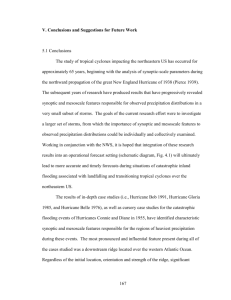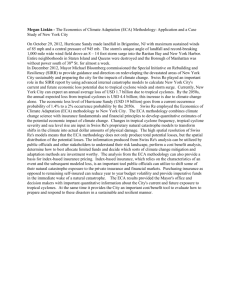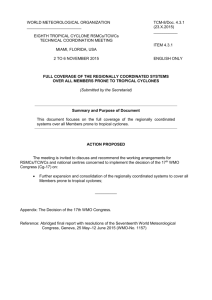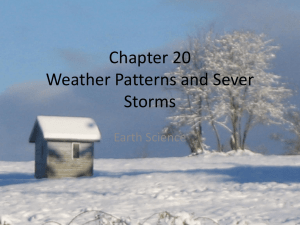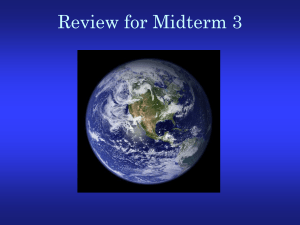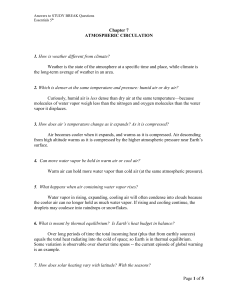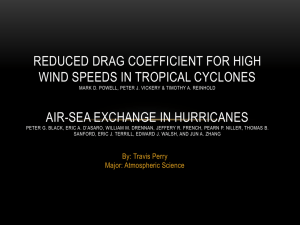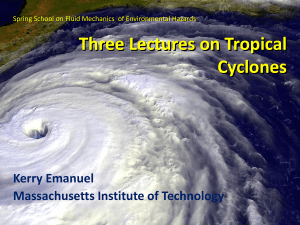Extratropical Cyclones
advertisement
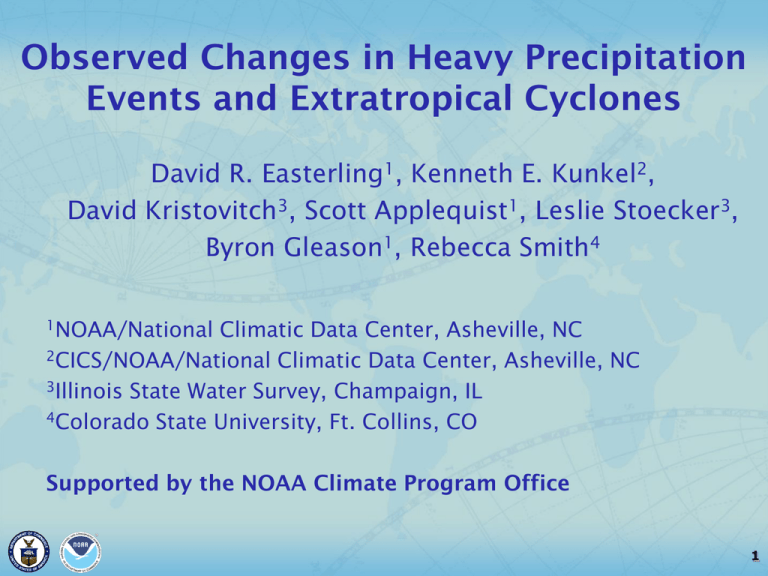
Observed Changes in Heavy Precipitation Events and Extratropical Cyclones David R. Easterling1, Kenneth E. Kunkel2, David Kristovitch3, Scott Applequist1, Leslie Stoecker3, Byron Gleason1, Rebecca Smith4 1NOAA/National Climatic Data Center, Asheville, NC 2CICS/NOAA/National Climatic Data Center, Asheville, NC 3Illinois State Water Survey, Champaign, IL 4Colorado State University, Ft. Collins, CO Supported by the NOAA Climate Program Office 1 Outline Meteorological causes of observed changes in heavy precipitation events in the USA. Changes in extra-tropical cyclones over the Northern Hemisphere. 1.8 Annual 1.6 +21% per Century Frequency Index 1.4 1.2 1.0 0.8 0.6 0.4 1890 1910 1930 1950 1970 1990 2010 Year Updated from Kunkel, K. E., D.R. Easterling, K. Redmond, and K. Hubbard, 2003: Temporal variations of extreme precipitation events in the United States: 1895–2000, Geophys. Res. Lett., 30, 1900, 10.1029/2003GL018052 What’s Causing The Increase? Have there been secular changes in the frequency, intensity, and other characteristics of the meteorological phenomena producing heavy precipitation? Are the recent increases primarily a result of increases in atmospheric water vapor concentrations? Or some combination of the above? U.S. Climate Data U.S. Cooperative Observer Network in operation since late 1880s, used 935 long-term stations. Daily Observations – Max and Min Temperature, Precipitation, Snowfall, Snow Depth Long-term Precipitation Stations Extremes Definition Event Duration – days Recurrence (threshold exceedance) – years 1-day duration, 5-year recurrence Meteorological Types Extratropical Cyclones − − Frontal (at least ~300 km away from center of surface or upper low) ETC (near surface or upper low center) Tropical Cyclones Mesoscale Convective Systems Air Mass Convection Southwest Monsoon Upslope Data Sources For Synoptic Types Reanalysis pressure and temperature Tropical Cyclone tracks Surface fields of temperature and precipitation Daily weather maps Identification of types mostly based on judgment of authors. Seasonal Analysis 10 1.2 1.0 June-October +20% per Century Frequency Index 0.8 0.6 0.4 0.2 0.0 1890 1910 1930 1950 Year 1970 1990 2010 Spatial Analysis 12 Types 14 Frontal, ETC & Tropical Events Number of Heavy Events/Station 0.20 0.16 0.12 0.08 0.04 0.00 1900 1910 1920 1930 1940 1950 1960 1970 Year ETC Frontal Tropical 1980 1990 2000 2010 Other Events Number of Heavy Events/Station 0.04 0.03 0.02 0.01 0.00 1900 1910 1920 1930 1940 1950 1960 1970 Year Monsoon Air Mass MCC Upslope 1980 1990 2000 2010 Contribution of Tropical Cyclones HURDAT tropical cyclone tracks dataset Heavy precipitation event considered to be caused by tropical cyclone if it occurred within 5 degrees of track Heavy Precipitation Event Index Tropical Cylone Events 0.3 0.2 Appalachians +0.06 per century 0.1 Carolina Coast Florida Gulf Coast New England Southeast Inland 0.0 1895- 1901- 1911- 1921- 1931- 1941- 1951- 1961- 1971- 1981- 1991- 20011900 1910 1920 1930 1940 1950 1960 1970 1980 1990 2000 2008 Year Carolina Coast Heavy Precipitation Event Index 0.8 0.7 0.6 0.5 0.4 0.3 0.2 0.1 0 1895 1905 1915 1925 1935 1945 1955 Year 1965 1975 1985 1995 2005 Southeast Number of Heavy Events/Station 0.20 Frontal 0.15 0.10 TC 0.05 0.00 19091910 19111920 19211930 19311940 19411950 19511960 19611970 19711980 19811990 19912000 20012006 Decade ETC Frontal Monsoon Air Mass MCC Upslope TC Extra-tropical Cyclones: have ETC tracks shifted and have they become more intense? Use the 100+ year Historical Reanalysis being run by NOAA/Earth System Research Lab. Sea-level pressure, 2o grid, 6h, 56 ensemble members ETCs defined as local minimum, surrounded by +2 hPa contour. NH Mid-latitude cyclone frequency, normalized by 1959-97 mean & std dev. McCabe, G. J., M. P. Clark, and M. C. Serreze, 2001: Trends in Northern Hemisphere surface cyclone frequency and intensity. Journal of Climate, 14, 2763-2768. Tracked ETC counts for winter season (Nov-Mar) ending in the year indicated. NH High-latitude cyclone frequency, normalized by 1959-97 mean & std dev. CONCLUSIONS The observed national upward trend in heavy precipitation frequency is due primarily to trends during June through October Statistically significant upward trends in the # of events caused by frontal systems and tropical cyclones Upward trends in tropical cyclone events in all Atlantic and Gulf regions except for Florida Extratropical Cyclones Results from NOAA Historical Reanalysis compare well with previous analyses for post 1950 period. If pre-1950 period included relative increase from 1900-1950 for midlatitudes, relative decline from 1920s for high latitudes. Questions? David.Easterling@noaa.gov



